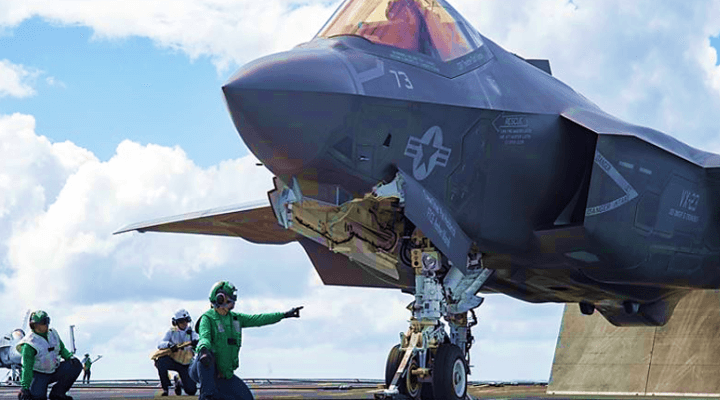Stop me if you’ve heard this one before. The Department of Defense continues to face daunting challenges in its procurement of the F-35 Lightning II Joint Strike Fighter, already the most expensive weapons system ever built.
Under Secretary of Defense for Acquisition, Technology, and Logistics Ellen Lord is scheduled to meet with Lockheed Martin CEO Marillyn Hewson next Monday, and the two will have lots to talk about.
Primer production problems, plus hypoxia
The latest burn is the news, first reported by Reuters yesterday, that Lockheed Martin failed to apply a protective coating properly in a spot where a carbon-fiber panel attaches to the fighter’s aluminum fuselage. Mechanics at Utah’s Hill Air Force Base found “corrosion exceeding technical limits,” caused by the lack of this primer, halting the already behind-schedule production for 30 days so the manufacturer could fix the issue.
The Air Force insists the corrosion did not affect the airworthiness of the plane, but it’s another black eye for Lockheed Martin and the F-35 program. Late last week, officials at Luke Air Force Base in Arizona revealed that some pilots are still experiencing episodes of hypoxia (or some other hypoxia-like episode), a feeling of dizziness and disorientation caused by a lack of oxygen. The Air Force temporarily grounded the F-35 at Luke AFB in June after five pilots reported suspected-cases of hypoxia.
But since resuming flights, three more pilots at Luke AFB and two pilots elsewhere have reported the symptoms. Needless to say, a multi-billion dollar aircraft is useless if it makes its pilots pass out.
The hypoxia revelations, though are but one problem. That revelation came on the same day that the Government Accountability Office, the government’s internal financial watchdog, released a report on F-35 sustainment contracts. It would seem that in an effort to be seen as a leader in new procurement methods, the F-35 joint program office is, to borrow a phrase from the Army (the one service not involved in the F-35 program), leaning a little too far forwarding the foxhole.
problems with performance-based contracting
The F-35 isn’t just expensive to build, it’s expensive to keep in the air. The DoD’s Director of Cost Assessment and Program Evaluation estimates that the Air Force, Navy, and Marine Corps will collectively spend $1.12 trillion — yes, trillion with a “t” — to sustain the fleet over its 60-year life-cycle. That’s an average of $18.67 billion per year.
To try to control that almost astronomical sum, the JPO is turning to performance-based contracting. As the Federal Acquisition Regulations outline the method, work is to be described, “in terms of the required results rather than either ‘how’ the work is to be accomplished or the number of hours to be provided.” In exchange for meeting or exceeding prescribed performance standards, contractors receive financial incentives.
Performance-based contracting is the future of government procurement. But in order for it to work properly, the government and contractor must both have a clear understanding of the cost involved, and what constitutes a realistic expectation for performance. As the GAO reported, the F-35 program lacks both of those. The F-35 program is akin to (pardon the analogy) building the aircraft while it’s already in flight. The government is still developing and testing the aircraft even as it continues to build it.
The services must still maintain the current fleet of 250 F-35s. But to do that, according to the GAO, the program is not nearly mature enough to implement performance-based contracting properly. The crux of the matter, according to the report, is that the DoD “does not have full information on F-35 sustainment costs and technical characteristics such as reliability and maintainability, which could hinder its ability to effectively negotiate performance-based contracts with the contractor by 2020.”
For example, the program’s objectives for depot-level repair of a part is 60 to 90 days, but current repair backlogs and supply chain shortages have put that figure at 172 days. GAO says this is because military repair depots are six years behind schedule in building the capacity to meet that goal. Because of the lack of information, “DOD risks overpaying the contractor for sustainment support that does not meet warfighter requirements.”
NBC News used to run an ongoing segment called “The Fleecing of America” that examined wasteful government spending. Tom Brokaw would be having a field day with the F-35 program.




